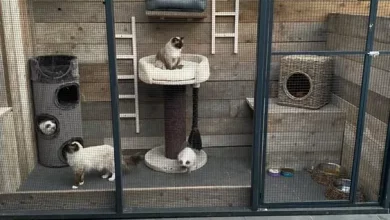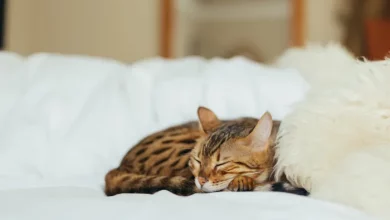Cute and Cuddly Cats: Discover the World of Feline Fun
Welcome to the wonderful world of cats! These adorable feline creatures are known for their playful nature, cuddly appearance, and unique personalities. Whether you’re a cat lover or new to the world of felines, you’re in for a treat.

In this article, we’ll explore the different aspects of cats that make them the perfect pets to have in your home. From choosing the right breed to creating a safe space for your furry friend, we’ve got you covered.
We’ll also provide tips on how to keep your cat healthy, happy, and entertained. Moreover, we’ll discuss the emotional connection between humans and cats and how to strengthen the bond between you and your feline friend.
So, let’s dive into the world of cute and cuddly cats and discover the joy and amusement they can bring to your life!
Choosing Your Feline Friend: Which Cat Breeds are Best for You?
Cats come in different shapes, sizes, and colors, and each breed has its own unique features and personality. Choosing the right cat breed is essential for a happy and healthy cat-human relationship. Here are some popular cat breeds and their characteristics to help you make an informed decision:
| Cat Breed | Characteristics |
|---|---|
| Persian | Long, silky hair; quiet and docile; requires daily grooming |
| Maine Coon | Gentle giant; large size; sociable and intelligent; playful |
| Siamese | Distinctive blue eyes and dark points; vocal and demanding; active and playful; requires attention and exercise |
| Scottish Fold | Folded ears; affectionate and adaptable; playful and curious |
If you are looking for a more laid-back cat, breeds like the Persian or the British Shorthair might be a good fit for you. If you prefer an active and playful cat, breeds like the Siamese or the Abyssinian could be a great choice. If you have a family or other pets, breeds like the Maine Coon or the Ragdoll are typically good with children and other animals.
Factors to Consider when Choosing a Cat Breed
When selecting a cat breed, it is important to consider your lifestyle, living situation, and preferences. Here are some things to keep in mind:
- Do you have time for daily grooming?
- How much space do you have for a cat to play and exercise?
- Do you have allergies to cat hair?
- Do you want a lap cat or a more independent cat?
- How much time and attention can you devote to your cat?
By considering these factors and researching different cat breeds, you can find the perfect feline friend to fit your lifestyle and personality.
Preparing for Your Furry Friend: Essential Items for Your Cat.
Cats are adorable creatures that make amazing pets. But before bringing your furry friend home, you need to ensure that you have all the essential items to keep your cat happy, healthy and comfortable. Here are some must-have supplies:
| Item | Description |
|---|---|
| Cat food | Cats need a balanced diet that provides them with the necessary nutrients for growth and development. Choose high-quality food that suits your cat’s age and health condition. |
| Litter box and litter | Cats are naturally clean animals and need a clean litter box to do their business. Choose a litter box that is large enough for your cat to move around in and provide litter that is easy to scoop and doesn’t have a strong scent. |
| Scratching post | Cats need to scratch to keep their claws healthy. Provide a scratching post to prevent your cat from scratching your furniture. |
| Bed | Cats love to sleep, and providing a comfortable bed can help them relax and feel secure. |
| Toys | Cats love to play, and toys can help them stay active and mentally stimulated. Provide toys that are safe and interactive. |
| Grooming tools | Cats need regular grooming to keep their coat healthy and shiny. Provide a brush and nail clippers to groom your furry friend regularly. |
When it comes to cat supplies, it’s important to create a safe and welcoming space for your furry friend. Make sure that your cat has access to food and clean water at all times, and keep their litter box in a quiet and private location. With the right supplies and care, your cat will thrive in their new home.
The First Days with Your Cat: How to Help Your Feline Friend Adjust.
Bringing a new cat home can be an exciting experience, but it’s important to make sure your feline friend feels safe and comfortable in their new environment. Here are some tips to help your cat adjust to their new home.
Introducing Your Cat to Other Pets and Family Members
If you have other pets or family members in your home, it’s important to introduce your new cat to them slowly. Allow your cat to explore their new surroundings for a few days before introducing them to other pets or family members.
When introducing your cat to other pets, make sure to supervise their interactions closely. Keep your cat in a separate room at first and gradually introduce them to the other pet’s scent before allowing them to meet in person.
Remember to give your cat plenty of attention and reassurance during this time, as they may feel overwhelmed by the new environment and unfamiliar faces.
Litter Box Training
Make sure your cat knows where the litter box is located, as they will need to use it frequently throughout the day. Place the litter box in a quiet and accessible location, away from their food and water dishes.
If your cat doesn’t seem to be using the litter box, try changing the type of litter or the location of the box. It’s also important to clean the litter box regularly to ensure your cat has a clean and comfortable place to do their business.
Understanding Cat Behavior
Cats can be independent creatures, but they still require love and attention from their owners. Spend time with your cat every day, playing and cuddling with them to strengthen your bond.
It’s also important to recognize when your cat is feeling stressed or anxious. Signs of stress in cats include hiding, excessive grooming, loss of appetite, and aggression. If you notice any of these behaviors in your cat, try to identify the source of their stress and make changes to the environment or their routine to help them feel more at ease.
By following these tips, you can help your new cat feel at home in their new environment and ensure a happy and healthy relationship between you and your furry friend.
Keeping Your Cat Healthy: Tips for Good Cat Care.
As a cat owner, you want to ensure that your furry friend is healthy and happy. Here are some tips for good cat care:
- Provide a balanced diet: Cats are obligate carnivores and require a diet that is high in protein and low in carbohydrates. Choose high-quality cat food that contains all the necessary nutrients.
- Schedule regular vet checkups: Annual checkups are critical in detecting and preventing health issues. Your vet can also advise on vaccinations and antiparasitic treatments.
- Groom your cat regularly: Regular grooming, including brushing, nail trimming, and ear cleaning, can prevent skin problems and infections. It’s also a great bonding activity.
- Keep your cat active: Regular playtime and exercise can help maintain your cat’s physical and mental health. Provide appropriate toys and scratching posts to keep them entertained.
- Monitor your cat’s behavior: Cats are masters of hiding their pain or discomfort, so it’s essential to keep an eye on their behavior. Look out for changes in appetite, litter box habits, and overall demeanor.
- Keep your home cat-friendly: Make sure your home is safe for your cat by removing hazardous items and providing a designated space for them to play, eat, and rest. Keep household chemicals, plants, and medication out of reach.
By following these tips, you can ensure that your cat stays healthy and happy for years to come.
Playing with Your Cat: Fun and Games for Feline Friends
Playing with your cat is not only fun, but it’s also essential for their physical and mental health. Here are some tips for keeping your furry friend entertained:
- Provide a variety of toys: Cats love to play with different types of toys, so make sure to offer a variety of options such as balls, soft toys, and interactive toys.
- Make time for play: Set aside at least 15-30 minutes each day to play with your cat. This will help them burn off excess energy and strengthen your bond.
- Use your imagination: Cats love to play hide-and-seek, chase, and hunt. Get creative with your games by hiding toys around the house or using feathers or strings to mimic prey.
Here are some games that are perfect for playing with your cat:
| Game | Description |
|---|---|
| Fetch | Cats can learn to fetch just like dogs. Toss a toy and encourage your cat to bring it back to you. |
| Interactive toys | Toys that require your cat to figure out a puzzle or manipulate an object can keep them entertained for hours. |
| Laser pointer | Cats love chasing laser pointers, but make sure not to shine it directly in their eyes. |
Remember to always supervise your cat during playtime and never force them to play if they’re not in the mood. With these tips and tricks, you and your feline friend are sure to have a great time together.
The Social Life of Cats: Building a Community for Your Feline Friend.
Just like humans, cats are social animals and enjoy the company of others. While they may have a reputation for being solitary creatures, cats thrive on socialization with other cats and humans.
If you are hoping to introduce your cat to other feline friends, it is essential to take things slow. Cats can be territorial, so it is best to introduce them in a neutral space, such as a park or a friend’s house. Make sure that each cat has their own space, litter box, and food and water bowls.
| Tip: | It’s important to supervise the first few interactions between cats to ensure that they are getting along and that there is no aggression. With time and patience, most cats can learn to live and play together peacefully. |
|---|
Creating a community of cat owners is an excellent way to provide socialization for your feline friend. Joining a local cat group or starting one of your own can create opportunities for playdates and socializing. Online cat communities and social media groups can also be a great way to connect with other cat owners and share advice and stories.
Tip: When introducing your cat to new people or pets, it’s important to read their body language. If your cat seems stressed or uncomfortable, it’s best to remove them from the situation and try again when they are feeling more confident.
Regular playtime with your cat is also an essential part of their socialization. Interactive toys, such as feathers and laser pointers, can help encourage your cat to play and bond with you.
- Join a local cat group to meet other cat owners and plan playdates for your feline friends.
- When introducing your cat to new cats or people, take things slow and read their body language to ensure they are comfortable.
- Regular playtime with interactive toys can help encourage your cat to socialize and bond with you.
By building a community for your cat and providing opportunities for socialization, you can help them lead a happy and fulfilled life.
Cats and Humans: Understanding the Bond Between Humans and Felines.
There’s a reason why cats have been domesticated for over 10,000 years. They have a unique ability to form emotional connections with humans, making them the perfect pets for people seeking companionship and unconditional love.
But what is it about cats that make them such great companions? For starters, cats are independent creatures, yet they still crave attention and affection from their human caregivers. They’re also incredibly perceptive, and they have a sixth sense when it comes to their humans’ emotions. If you’re feeling down, your cat might come cuddle with you or offer you a soft purr as a way of comforting you.
Some might argue that the bond between cats and humans is different from that of dogs and humans. While dogs are known for their loyalty and eagerness to please their owner, cats show their affection in more subtle ways. They might rub against your leg or knead on your lap to show you that they trust and love you.
It’s important to note that the bond between humans and cats is a two-way street. Cats need love and care from their humans to form a strong emotional connection. This means providing them with food and water, offering them a safe and comfortable home, and spending quality time with them each day. By doing so, you’re not only strengthening your bond with your cat, but you’re also improving their overall health and wellbeing.
So, whether you’re a first-time cat owner or a seasoned feline lover, remember that the bond between humans and cats is a special one. Take the time to nurture your relationship with your cat, and you’ll be rewarded with years of love and companionship.
FAQs: Answering Your Questions About Cute and Cuddly Cats.
Are cats good pets for children?
Cats can be great pets for children, but it’s important to choose a cat breed that is known for being good with kids. Breeds such as the Maine Coon, Ragdoll and Siamese can make great family pets. It’s also important to supervise interactions between children and cats to prevent any accidental injuries.
How often should I take my cat to the vet?
Cats should have a checkup with a veterinarian at least once a year. This will allow the vet to catch any potential health issues early on and ensure that your cat is up to date on vaccinations. If your cat is a senior or has a pre-existing health condition, more frequent vet visits may be necessary.
What kind of litter box is best for my cat?
There are many different types of litter boxes available, but it’s important to choose one that your cat is comfortable using. Covered litter boxes can provide more privacy, while self-cleaning litter boxes can save time and effort. Make sure to keep the litter box clean and provide enough boxes for your cat if you have multiple cats in your household.
Should I declaw my cat?
Declawing a cat involves the amputation of the cat’s toes up to the first joint, and can have long-lasting negative effects on the cat’s physical and emotional health. It is also illegal in some countries and states. Instead, consider providing your cat with scratching posts and training them to use them.
How do I introduce my cat to a new pet?
Introducing cats to new pets should be done slowly and carefully to ensure a positive outcome. Start by keeping the pets in separate rooms and gradually introduce them to each other’s scent. Supervised interactions can then take place once both animals are comfortable with each other’s presence.
What should I do if my cat is not eating?
A cat not eating can be a sign of a serious health issue, so it’s important to consult with a veterinarian if your cat refuses food for more than 24 hours. In the meantime, try offering your cat different types of food and make sure they have access to fresh water. Stress and dental issues can also sometimes cause a cat to stop eating.
Do cats need to be bathed?
Cats are generally self-cleaning animals and do not need regular baths. However, if your cat gets into something particularly dirty or smelly, a bath may be necessary. Use a cat-specific shampoo and make sure to rinse thoroughly to avoid skin irritation. It’s important to never use human shampoo or soap on a cat.








